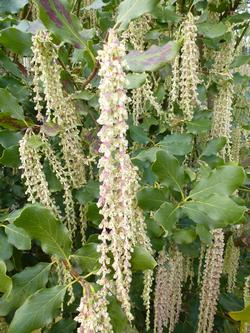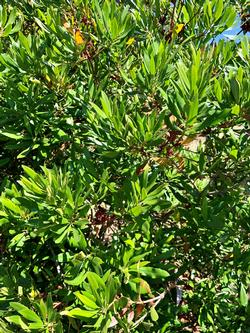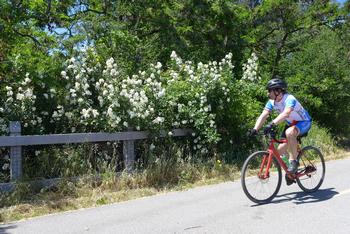Go native when planting your hedges
-
James Campbell
-
 Garrya elliptica can grow 20-30 feet; ‘Evie' is the denser, more compact variety. Photo: Silex
Garrya elliptica can grow 20-30 feet; ‘Evie' is the denser, more compact variety. Photo: Silex
I have deer fencing on one side of my property, which I put in seven years ago. My plan was always to plant a hedge, too, but I never got to it. I would have had a nicely established hedge by now, my neighbor joked with me recently. My plant choice for a hedge would have been very different back then. Now I must consider the drought, and I am more aware of the importance of earth-friendly gardening.Several factors make a garden earth-friendly. I am making my list choosing plants that will thrive in our local climate, which is summer-dry. I limited my choices to native, low water plants that can work as hedges, and there is a good selection. Choosing native plants is earth-friendly not only because they conserve water. Native plants create habitats for native birds, insects, bees, and other mammals. Let's say most mammals. I do not want to create a habitat for the deer, so the plants on this list are still considered deer-resistant.
 Myrica californica is a california native that makes a great privacy hedge. Photo: James Campbell
Myrica californica is a california native that makes a great privacy hedge. Photo: James Campbell
Pacific wax myrtle is probably the most common native plant I have observed as a hedge in my town. It prefers full sun, especially along the coast, but can take some shade and can adapt to loamy, sandy, or clay soils. Pacific wax myrtle, or Myrica californica, is drought tolerant, but can take watering. It grows about 2-4 feet a year, eventually topping out between 20 and 30 feet tall. A long-lived plant that looks great as an informal hedge or clipped into a more manicured look. The flowers are inconspicuous but yield brownish-purple fruit that birds love to eat.
Several species of manzanita, Arctostaphylos, can work as hedges. As with all plants, assess your site. The right plant in the right place is the golden rule. Most manzanitas prefer full sun, good drainage, and low water, but some species are more forgiving than others. ‘Howard McMinn’ is a native variety from Sonoma County that does well in Marin gardens. It can adapt to heavy soils, irrigation, some shade and tolerates pruning and shearing, making it an excellent hedging choice. If you have good drainage, consider manzanita hybrid ‘Sunset’, which can be sheared on its sides to encourage height. If you need a tall hedge, ‘Dr. Hurd’ manzanita can grow up to 15 feet and tolerates our clay soils in Marin. Because manzanita bloom in the winter months, they provide a nectar source for native bees, butterflies, and hummingbirds at a time when little else is available. The fruits that develop after are an attractive food source to birds and other mammals.Who wouldn't love a hedge covered with flowers in the spring? Although I have two bush anemones, Carpenteria californica, in my garden already, I never considered them as hedging material until I was doing my research. Carpenteria do well in full sun and part shade as long as they have good drainage. Mine thrive on a hillside and have never been on irrigation. Plants will maintain a lovely rounded form, but if pruning is needed, cut back to lower buds after flowering. Growing 8 feet tall, they flower in May and June, attracting happy pollinators. Carpenteria californica is a California native shrub grown in gardens around the world and makes a lovely hedge. Photo: Jean Pawek
Carpenteria californica is a California native shrub grown in gardens around the world and makes a lovely hedge. Photo: Jean PawekSilktassel or Garrya elliptica, works well as an informal hedge and is native to our coastal range. It can be grown in full sun, part shade and is not fussy about soil types. Silktassel is famous for its catkins (long, pendant flowers) which bloom in the winter. The male plants have showier, longer catkins, but both sexes must be present for the female plants to produce the purple berries that birds love. Prune immediately after flowering, if necessary. ‘Evie ‘variety is denser in form, so it works best as a hedge. Silktassel grows fast in the right conditions and tops out at 20-30 feet.
Please design and plant privacy hedges in a Fire-smart way. Unbroken, continuous hedges of plants grown closely together could become pathways for wildfire to travel to structures or other plantings. If space allows, visual privacy can be provided by overlapping and staggered small groups of hedge plants separated by three-dimensional space forward and back between them to provide fire breaks.For more information on earth-friendly gardening and photos of native plants that thrive in Marin, visit our website at marinmg.ucanr.edu.



